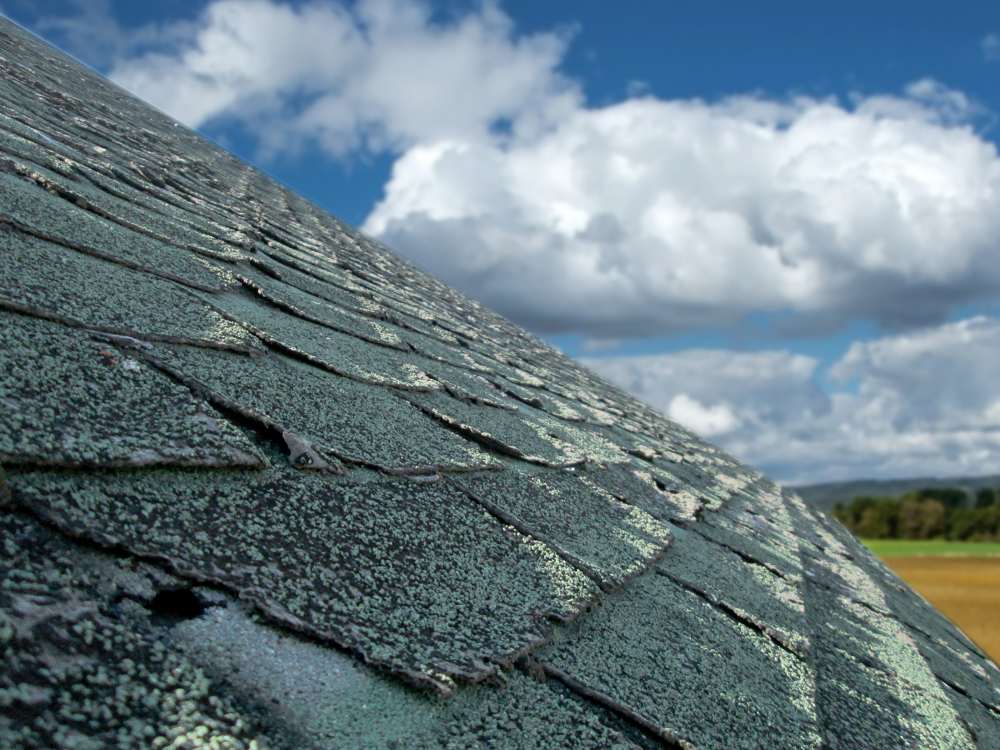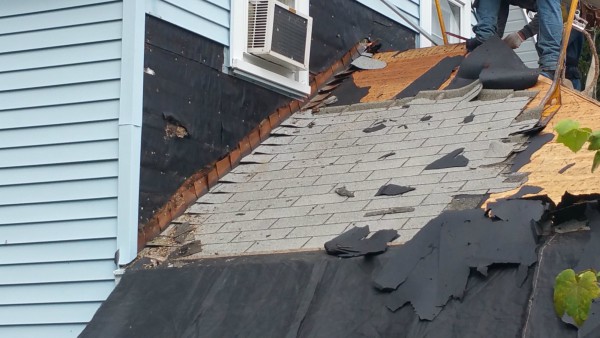
Key Takeaways
✔ Hail damage is often subtle and not always visible from the ground.
✔ Ignoring hail damage leads to more severe and costly problems
✔ Professional inspections are essential after a hailstorm.
✔ Different roofing materials show hail damage differently.
✔ Timely repair is critical for protecting your home and warranty.
Table of Contents
Hailstorms can wreck your roof in minutes—and the damage isn’t always obvious.
When a hailstorm rolls through, your car isn’t the only thing at risk. Your roof often takes the hardest hit, and the damage isn’t always easy to spot. Across the U.S., hailstorms rack up billions of dollars in property damage each year, and your roof is usually the first line of defense.
Ignoring hail damage can turn a small issue into a costly problem. What starts as a few dents or missing granules may snowball into roof leaks, water damage, and even the need for a full roof replacement. The good news? With the right knowledge and a trusted contractor by your side, you can catch the signs early and prevent long-term damage.
For homeowners in Poughkeepsie, NY, Lyndsey Roofing has built a reputation for helping families identify hail damage quickly and repair it with lasting solutions.
What Does Hail Damage Look Like on a Roof?
Those ice balls from last night’s storm might have left more than dents in your gutters—they could be tearing years off your roof’s lifespan.
From the ground, hail damage can be subtle. You might notice dents in gutters, dings on siding, or chipped paint—but the real story is told on your shingles. On close inspection, hail damage often shows up as dark spots, missing granules, or small circular dents that break down your roof’s protective layer.
The challenge is that hail damage doesn’t always scream “urgent.” Left alone, though, it shortens the lifespan of your roof. That’s why professional inspections are crucial. Roofing experts like Lyndsey Roofing know how to identify even the smallest signs of hail impact and prevent them from escalating into costly repairs.
How Can You Tell if Your Roof Has Been Damaged by Hail?
Visible signs from the ground
- Dents or dings on gutters, downspouts, or siding
- Chips or cracks in paint or wood trim
- Damage to outdoor AC units or patio furniture
Signs up close
- Granule loss on shingles, leaving shiny black areas exposed
- Soft spots that feel spongy under pressure
- Cracks or breaks in shingles that compromise water protection
Professional inspection benefits
Getting a pro on your roof isn’t just safer—it’s smarter. Professional roofers can properly document hail strikes for insurance claims, spot hidden structural damage, and make sure nothing is overlooked.

What Does Roof Damage Look Like?
Not all roof damage is created equal. Aging shingles or wind damage can look different than hail strikes. Knowing the difference helps you decide whether you’re dealing with routine wear or storm-related destruction.
✔ Shingle bruising and dents
Small, round dark spots that indicate impact. These areas weaken over time.
✔ Missing or loose granules
Hail often knocks protective granules off shingles, leaving bald spots that speed up roof deterioration.
✔ Cracked or broken shingles
Hail strikes can split shingles, allowing water to seep underneath.
✔ Water leaks and interior stains
If hail damage goes unchecked, the first signs inside your home may be water stains on ceilings or walls.
What is the Proper Way to Mark a Hail Damaged Shingle?
Roofing professionals typically use chalk to outline hail strikes during an inspection. This ensures that each hit is clearly identified and separated from other wear and tear, like blistering or normal aging.
Accurate marking is crucial, especially when insurance adjusters are involved. Proper documentation means fair repair estimates and faster claim approvals. Lyndsey Roofing follows this process to ensure homeowners get the coverage they deserve.
What Kind of Damage Can Hail Do to a Roof?
✔ Asphalt shingle roofs
Asphalt shingles are the most common roofing material in the U.S., and unfortunately, they’re also highly vulnerable to hail. When hailstones hit, they can knock off the protective granules that shield shingles from UV rays and weather. This “bruising” weakens the shingles and shortens their lifespan. Over time, the loss of granules leaves bare spots where water can seep in, leading to leaks and further roof deterioration.
✔ Metal roofs
Metal roofs are tougher, but they’re not invincible. Hailstones often leave behind visible dents and scratches. While dents may seem cosmetic at first, deeper impacts can damage the protective coating. Once that coating is compromised, the roof becomes more prone to rust, corrosion, and long-term weakening. For homeowners, that means regular inspections are critical after a storm to prevent small issues from turning into structural problems.
✔ Tile or slate roofs
Tile and slate roofs are durable, but they can crack or even shatter under the force of larger hailstones. Cracks may not be immediately noticeable from the ground, but even small fractures compromise the roof’s ability to shed water. Over time, water sneaks through these cracks, damaging the underlayment and potentially the structure beneath. Replacing broken tiles promptly is the only way to keep the system watertight.
✔ Long-term issues
Hail damage isn’t always just about what you can see on day one. Left untreated, even minor damage creates a chain reaction of problems. Water leaks can ruin insulation, cause interior drywall damage, and lead to mold growth that threatens your family’s health. Compromised shingles and tiles also make your home less energy-efficient, which can drive up heating and cooling costs. What looks like a small dent today could turn into thousands of dollars in damage tomorrow if repairs are delayed.

How to Fix Hail Damage on the Roof of a House
Professional roof inspection is the first step
The smartest move after a hailstorm is to call a roofing contractor. A professional inspection reveals damage you might miss from the ground and provides the documentation needed for insurance claims.
Temporary fixes homeowners can do
Until help arrives, you can minimize damage by tarping exposed areas or sealing small leaks. These are short-term measures—only a professional can deliver lasting roof repair.
Repair vs. replacement
Not all hail damage requires a new roof. If only a few shingles are affected, targeted repairs may be enough. But when damage is widespread, a full roof replacement often saves more money in the long run by preventing recurring issues.
Working with insurance
Filing a claim without proof of damage is tough, so documentation is everything. Contractors like Lyndsey Roofing provide detailed inspection reports and estimates that streamline the insurance claims process. If you suspect hail damage, schedule an inspection with your trusted local contractor for hail damage roof repair in Poughkeepsie, NY.
Why Timely Hail Damage Repair Matters
Delaying hail damage repairs is risky. What starts as a few dents or missing granules quickly turns into cracked shingles, roof leaks, and even voided warranties. The longer you wait, the higher the repair bill climbs. Acting fast protects both your home and your wallet.
With Lyndsey Roofing’s quick response and proven expertise, you’ll have peace of mind knowing your roof is secure before the next storm rolls in.
Frequently Asked Questions
How do I know if my roof has hail damage?
Look for visible dents on shingles, gutters, and siding. Professional inspections are the best way to confirm roof hail damage. Even if your roof looks fine from the ground, hidden bruises or granule loss may still be present. Check for water stains on ceilings or attic leaks as secondary signs of damage. Calling a local roofing contractor ensures nothing is overlooked and your insurance claim is supported.
Can hail damage be repaired, or do I need a new roof?
Minor damage may be repaired with shingle replacement. Extensive hail damage may require a full roof replacement for long-term protection. Roofing professionals will determine whether patch repairs are enough or if a replacement is more cost-effective. Attempting DIY fixes often voids warranties and leads to missed damage. A certified inspection will help you understand your options clearly.
Will insurance cover hail damage to my roof?
Most homeowners’ insurance policies cover hail damage roof repair or replacement, but coverage depends on your policy and inspection results. Insurance companies often require detailed documentation of damage to approve claims. Working with a roofing contractor who understands the claims process makes it smoother. Quick reporting after the storm improves your chances of getting full coverage.
How soon should I fix hail damage on my roof?
Repairs should be done as soon as possible. Delays can worsen the damage, leading to leaks, mold growth, and higher repair costs. Most insurance policies expect you to act quickly to prevent further damage. Immediate repairs protect your roof’s warranty and extend its lifespan. Fast action also prevents minor cosmetic issues from turning into structural problems.
How big does hail need to be to damage a roof?
Hail as small as 1 inch can cause roof damage, especially to asphalt shingles. Larger hailstones increase the risk of cracks, dents, and leaks. Factors like wind speed, roof age, and material all affect the level of damage. Even pea-sized hail can strip granules off shingles over time. After any hailstorm, it’s best to schedule an inspection rather than guess.

Schedule Your Roof Inspection with Lyndsey Roofing Today!
A tiny hail dent today can become a major roof replacement tomorrow. Don’t give hidden damage the chance to grow. Don’t wait until a small hail dent turns into a major roof leak. Protect your home today with expert help from Lyndsey Roofing.
Schedule your roof inspection and get a free estimate today — let our team provide reliable hail damage roof repair in Poughkeepsie, NY, and surrounding areas.







